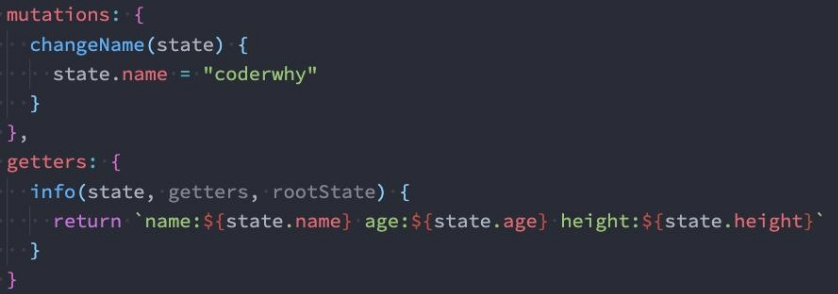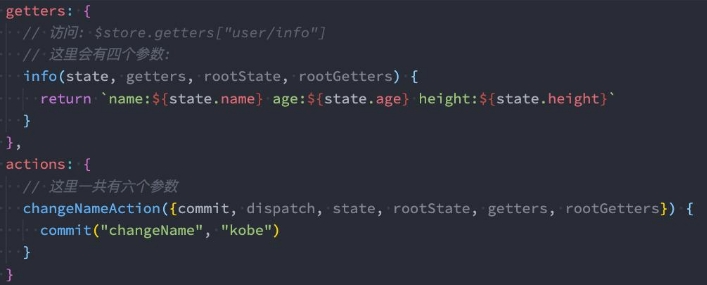Vue全家桶 - Vuex状态管理
总结
2.1. 理解状态管理
2.2. Vuex基本使用
- 安装vuex
- 创建store
- app.use(store)
- tempate -> $store.state.counter
2.3. 核心概念一State
2.3.1. 基本使用
2.3.2. 映射使用
- options api
- composition api
2.4. 核心概念二getter
2.4.1. 基本使用
- 直接使用
- 引入别的getters
- 返回函数, 接收参数
2.4.2. 映射使用
- options api
- composition api
2.5. 核心概念三Mutations
2.5.1. 重要原则
- 修改state, 必须使用mutation
2.5.2. 基本使用
- 直接使用
- 传入参数
2.5.3. 映射使用
2.5.4. 重要原则
- 不要在mutation执行异步操作, 必须同步操作
2.6. 核心概念四Actions
2.6.1. actions的基本使用
- 定义action
- dispatch派发action
2.6.2. actions的辅助函数
2.6.3. actions的异步操作
- home.vue -> home.js -> actions发送请求
2.6.4. action结果返回Promise(了解)
2.7. Module的使用
2.7.1. module的基本使用
- 抽取到对象:
- state
- mutations
- getters
- actions
- modules: { home: 对象 }
- state.home.xxx
- getters.xxx
- commit
- dispatch
2.7.2. module的命名空间
- namespaced: true
- getters["home/xxx"]
- commit("home/xxx")
认识应用状态管理
什么是状态管理
- 在开发中,我们会的应用程序需要处理各种各样的数据,这些数据需 要保存在我们应用程序中的某一个位置,对于这些数据的管理我们就 称之为是 状态管理。
- 在前面我们是如何管理自己的状态呢?
- 在Vue开发中,我们使用组件化的开发方式;
- 而在组件中我们定义data或者在setup中返回使用的数据,这些数 据我们称之为state;
- 在模块template中我们可以使用这些数据,模块最终会被渲染成 DOM,我们称之为View;
- 在模块中我们会产生一些行为事件,处理这些行为事件时,有可能 会修改state,这些行为事件我们称之为actions;
复杂的状态管理
- JavaScript开发的应用程序,已经变得越来越复杂了:
- JavaScript需要管理的状态越来越多,越来越复杂;
- 这些状态包括服务器返回的数据、缓存数据、用户操作产生的数据等等;
- 也包括一些UI的状态,比如某些元素是否被选中,是否显示加载动效,当前分页;
- 当我们的应用遇到多个组件共享状态时,单向数据流的简洁性很容易被破坏:
- 多个视图依赖于同一状态;
- 来自不同视图的行为需要变更同一状态;
- 我们是否可以通过组件数据的传递来完成呢?
- 对于一些简单的状态,确实可以通过props的传递或者Provide的方式来共享状态;
- 但是对于复杂的状态管理来说,显然单纯通过传递和共享的方式是不足以解决问题的,比如兄弟组件如何共享数据呢?
Vuex的基本使用
Vuex的状态管理
管理不断变化的state本身是非常困难的:
- 状态之间相互会存在依赖,一个状态的变化会引起另一个状态的变化,View页面也有可能会引起状态的变化;
- 当应用程序复杂时,state在什么时候,因为什么原因而发生了变化,发生了怎么样的变化,会变得非常难以控制和追踪;
因此,我们是否可以考虑将组件的内部状态抽离出来,以一个全局单例的方式来管理呢?
- 在这种模式下,我们的组件树构成了一个巨大的 “试图View”;
- 不管在树的哪个位置,任何组件都能获取状态或者触发行为;
- 通过定义和隔离状态管理中的各个概念,并通过强制性的规则来维护视图和状态间的独立性,我们的代码边会变得更加结构 化和易于维护、跟踪;
- 这就是Vuex背后的基本思想,它借鉴了Flux、Redux、Elm(纯函数语言,redux有借鉴它的思想);
- 当然,目前Vue官方也在推荐使用Pinia进行状态管理,我们后续也会进行学习。

Vuex的安装
- 依然我们要使用vuex,首先第一步需要安装vuex:
- 我们这里使用的是vuex4.x;
npm install vuex
核心概念State
创建Store
每一个Vuex应用的核心就是store(仓库):
- store本质上是一个容器,它包含着你的应用中大部分的状态(state);
Vuex和单纯的全局对象有什么区别呢?
第一:Vuex的状态存储是响应式的
- 当Vue组件从store中读取状态的时候,若store中的状态发生变化,那么相应的组件也会被更新;
第二:你不能直接改变store中的状态
- 改变store中的状态的唯一途径就显示提交 (commit) mutation;
- 这样使得我们可以方便的跟踪每一个状态的变化,从而让我们能够通过一些工具帮助我们更好的管理应用的状态;
使用步骤:
- 创建Store对象;
- 在app中通过插件安装;
组件中使用store
在组件中使用store,我们按照如下的方式:
- 在模板中使用;
<h2>Home当前计数: {{ $store.state.counter }}</h2>- 在options api中使用,比如computed;
export default {
computed: {
storeCounter() {
return this.$store.state.counter
}
}
}- 在setup中使用;
import { toRefs } from 'vue'
import { useStore } from 'vuex'
const store = useStore()
const { counter } = toRefs(store.state) //这里需要使用toRefs,转化为响应式的。
function increment() {
// store.state.counter++
store.commit("increment")
}
单一状态树
Vuex 使用单一状态树:
- 用一个对象就包含了全部的应用层级的状态;
- 采用的是SSOT,Single Source of Truth,也可以翻译成单一数据源;
这也意味着,每个应用将仅仅包含一个 store 实例;
- 单状态树和模块化并不冲突,后面我们会讲到module的概念;
单一状态树的优势:
- 如果你的状态信息是保存到多个Store对象中的,那么之后的管理和维护等等都会变得特别困难;
- 所以Vuex也使用了单一状态树来管理应用层级的全部状态;
- 单一状态树能够让我们最直接的方式找到某个状态的片段;
- 而且在之后的维护和调试过程中,也可以非常方便的管理和维护;
组件获取状态
- 在前面我们已经学习过如何在组件中获取状态了。
- 当然,如果觉得那种方式有点繁琐(表达式过长),我们可以使用计算属性:
export default {
computed: {
storeCounter() {
return this.$store.state.counter
}
}
}
- 但是,如果我们有很多个状态都需要获取话,可以使用mapState的辅助函数:
- mapState的方式一:对象类型;
- mapState的方式二:数组类型;
- 也可以使用展开运算符和来原有的computed混合在一起;
<template>
<div class="app">
<button @click="incrementLevel">修改level</button>
<!-- 1.在模板中直接使用多个状态 -->
<h2>name: {{ $store.state.name }}</h2>
<h2>level: {{ $store.state.level }}</h2>
<h2>avatar: {{ $store.state.avatarURL }}</h2>
<!-- 2.计算属性(映射状态: 数组语法) -->
<h2>name: {{ name }}</h2>
<h2>level: {{ level }}</h2>
<!-- 3.计算属性(映射状态: 对象语法) -->
<h2>name: {{ sName }}</h2>
<h2>level: {{ sLevel }}</h2>
</div>
</template>
<script>
import { mapState } from 'vuex'
export default {
computed: {
fullname() {
return "xxx"
},
...mapState(["name", "level", "avatarURL"]),
...mapState({
sName: state => state.name,
sLevel: state => state.level
})
}
}
</script>
在setup中使用mapState
在setup中如果我们单个获取装是非常简单的:
- 通过useStore拿到store后去获取某个状态即可;
- 但是如果我们需要使用 mapState 的功能呢?
默认情况下,Vuex并没有提供非常方便的使用mapState的方式,这里我们进行了一个函数的封装:
或者使用toRefs
<template>
<div class="app">
<button @click="incrementLevel">修改level</button>
<!-- 4.setup计算属性(映射状态: 对象语法) -->
<!-- <h2>name: {{ cName }}</h2>
<h2>level: {{ cLevel }}</h2> -->
<!-- 5.setup计算属性(映射状态: 对象语法) -->
<h2>name: {{ name }}</h2>
<h2>level: {{ level }}</h2>
</div>
</template>
<script setup>
import { computed, toRefs } from 'vue'
import { mapState, useStore } from 'vuex'
// 1.自己一步步写封装
const { name, level } = mapState(["name", "level"]) //mapstate返回的是一个对象{name:f,level:f},不能直接使用
const store = useStore()
const cName = computed(name.bind({ $store: store })) //name函数其实就是内部就是return this.$store.state,所以这里使用bind绑定一个{$store}
const cLevel = computed(level.bind({ $store: store }))
// 2.封装一个函数
function useMyState(mapper) {
const store = useStore()
const stateFnsObj = mapState(mapper)
const newState = {}
Object.keys(stateFnsObj).forEach(key => {
newState[key] = computed(stateFnsObj[key].bind({ $store: store }))
})
return newState
}
const { name, level } = useMyState(["name", "level"])
// 3.直接对store.state进行解构(推荐)
const store = useStore()
const { name, level } = toRefs(store.state)
function incrementLevel() {
store.state.level++
}
</script>
核心概念Getters
getters的基本使用
- 某些属性我们可能需要经过变化后来使用,这个时候可以使用getters:
- getters第二个参数:可以获取其他的getters
- getters中的函数本身,可以返回一个函数,那么在使用的地方相当于可以调用这个函数:
{
getters: {
// 1.基本使用
doubleCounter(state) {
return state.counter * 2
},
totalAge(state) {
return state.friends.reduce((preValue, item) => {
return preValue + item.age
}, 0)
},
// 2.在该getters属性中, 获取其他的getters
message(state, getters) {
return `name:${state.name} level:${state.level} friendTotalAge:${getters.totalAge}`
},
// 3.getters是可以返回一个函数的, 调用这个函数可以传入参数(了解)
getFriendById(state) {
return function(id) {
const friend = state.friends.find(item => item.id === id)
return friend
}
}
}
}
mapGetters的辅助函数
- 这里我们也可以使用mapGetters的辅助函数。
<template>
<div class="app">
<h2>doubleCounter: {{ doubleCounter }}</h2>
<h2>friendsTotalAge: {{ totalAge }}</h2>
<!-- 根据id获取某一个朋友的信息 -->
<h2>id-111的朋友信息: {{ getFriendById(111) }}</h2>
</div>
</template>
<script>
import { mapGetters } from 'vuex'
export default {
computed: {
...mapGetters(["doubleCounter", "totalAge"]),
...mapGetters(["getFriendById"])
}
}
</script>
- 在setup中使用
<template>
<div class="app">
<h2>message: {{ message }}</h2>
</div>
</template>
<script setup>
import { computed, toRefs } from 'vue';
import { mapGetters, useStore } from 'vuex'
const store = useStore()
// 1.使用mapGetters
// const { message: messageFn } = mapGetters(["message"])
// const message = computed(messageFn.bind({ $store: store }))
// 2.直接解构, 并且包裹成ref
// const { message } = toRefs(store.getters)
// 3.针对某一个getters属性使用computed
const message = computed(() => store.getters.message)
</script>
核心概念Mutations
Mutation基本使用
- 更改 Vuex 的 store 中的状态的唯一方法是提交 mutation:
const store = createStore({
mutations: {
increment(state) {
state.counter++
},
changeName(state, payload) {
state.name = payload
}
}
})
Mutation携带数据
- 很多时候我们在提交mutation的时候,会携带一些数据,这个时候我们可以使用参数:

- payload为对象类型

- 对象风格的提交方式

Mutation常量类型
- 定义常量:mutation-type.js

- 定义mutation

- 提交mutation

mapMutations辅助函数
- 我们也可以借助于辅助函数,帮助我们快速映射到对应的方法中:

- 在setup中使用也是一样的:
<template>
<div class="app">
<button @click="changeName('王小波')">修改name</button>
<button @click="incrementLevel">递增level</button>
<button @click="changeInfo({ name: '王二', level: 200 })">修改info</button>
<h2>Store Name: {{ $store.state.name }}</h2>
<h2>Store Level: {{ $store.state.level }}</h2>
</div>
</template>
<script setup>
import { mapMutations, useStore } from 'vuex'
import { CHANGE_INFO } from "@/store/mutation_types"
const store = useStore()
// 1.手动的映射和绑定
const mutations = mapMutations(["changeName", "incrementLevel", CHANGE_INFO])
const newMutations = {}
Object.keys(mutations).forEach(key => {
newMutations[key] = mutations[key].bind({ $store: store })
})
const { changeName, incrementLevel, changeInfo } = newMutations
</script>
mutation重要原则
一条重要的原则就是要记住 mutation 必须是同步函数
- 这是因为devtool工具会记录mutation的日记;
- 每一条mutation被记录,devtools都需要捕捉到前一状态和后一状态的快照;
- 但是在mutation中执行异步操作,就无法追踪到数据的变化;
所以Vuex的重要原则中要求 mutation必须是同步函数;
- 但是如果我们希望在Vuex中发送网络请求的话需要如何操作呢?
核心概念Actions
actions的基本使用
Action类似于mutation,不同在于:
- Action提交的是mutation,而不是直接变更状态;
- Action可以包含任意异步操作;
这里有一个非常重要的参数context:
- context是一个和store实例均有相同方法和属性的context对象;
- 所以我们可以从其中获取到commit方法来提交一个mutation,或者通过 context.state 和 context.getters 来获取 state 和 getters;
但是为什么它不是store对象呢?这个等到我们讲Modules时再具体来说;

actions的分发操作
- 如何使用action呢?进行action的分发:
- 分发使用的是 store 上的dispatch函数;

- 同样的,它也可以携带我们的参数:

- 也可以以对象的形式进行分发:

actions的辅助函数
- action也有对应的辅助函数:
<template>
<div class="home">
<h2>当前计数: {{ $store.state.counter }}</h2>
<button @click="incrementAction">发起action修改counter</button>
<button @click="increment">递增counter</button>
<h2>name: {{ $store.state.name }}</h2>
<button @click="changeNameAction('bbbb')">发起action修改name</button>
</div>
</template>
<script>
import { mapActions } from 'vuex'
export default {
methods: {
// counterBtnClick() {
// this.$store.dispatch("incrementAction")
// },
// nameBtnClick() {
// this.$store.dispatch("changeNameAction", "aaa")
// }
// ...mapActions(["incrementAction", "changeNameAction"])
}
}
</script>
<script setup>
import { useStore, mapActions } from 'vuex'
const store = useStore()
// 1.在setup中使用mapActions辅助函数
const actions = mapActions(["incrementAction", "changeNameAction"])
const newActions = {}
Object.keys(actions).forEach(key => {
newActions[key] = actions[key].bind({ $store: store })
})
const { incrementAction, changeNameAction } = newActions
// 2.使用默认的做法
function increment() {
store.dispatch("incrementAction")
}
</script>
actions的异步操作
- Action 通常是异步的,那么如何知道 action 什么时候结束呢?
- 我们可以通过让action返回Promise,在Promise的then中来处理完成后的操作;


核心概念Modules
module的基本使用
- 什么是Module?
- 由于使用单一状态树,应用的所有状态会集中到一个比较大的对象,当应用变得非常复杂时,store 对象就有可能变得相当臃 肿;
- 为了解决以上问题,Vuex 允许我们将 store 分割成模块(module);
- 每个模块拥有自己的 state、mutation、action、getter、甚至是嵌套子模块;


module的局部状态
- 对于模块内部的 mutation 和 getter,接收的第一个参数是模块的局部状态对象:


module的命名空间
- 默认情况下,模块内部的action,mutation,Getter 仍然是注册在全局的命名空间中的:
- 这样使得多个模块能够对同一个 action 或 mutation 作出响应;
- Getter 同样也默认注册在全局命名空间;
- 如果我们希望模块具有更高的封装度和复用性,可以添加 namespaced: true 的方式使其成为带命名空间的模块:
- 当模块被注册后,它的所有 getter、action 及 mutation 都会自动根据模块注册的路径调整命名;
- 比如以下store
const store = createStore({
modules: {
counterModule: {
namespaced: true,
state: () => ({
count: 99
}),
mutations: {
incrementCount(state) {
console.log(state)
state.count++
}
},
getters: {
doubleCount(state, getters, rootState) {
return state.count + rootState.rootCounter
}
},
actions: {
incrementCountAction(context) {
context.commit("incrementCount")
}
}
}
}
})
- 不加
namespaced:true
<template>
<div class="home">
<h2>Home Page</h2>
<!-- 1.使用state时, 是需要state.moduleName.xxx -->
<h2>Counter模块的counter: {{ $store.state.counter.count }}</h2>
<!-- 2.使用getters时, 是直接getters.xxx -->
<h2>Counter模块的doubleCounter: {{ $store.getters.doubleCount }}</h2>
<button @click="incrementCount">count模块+1</button>
</div>
</template>
<script>
</script>
<script setup>
import { useStore } from 'vuex'
const store = useStore()
// 派发事件时, 默认也是不需要跟模块名称
// 提交mutation时, 默认也是不需要跟模块名称
function incrementCount() {
store.dispatch("incrementCountAction")
}
</script>
- 加
namespaced:true
<template>
<div class="home">
<h2>Home Page</h2>
<!-- 1.使用state时, 是需要state.moduleName.xxx -->
<h2>Counter模块的counter: {{ $store.state.counterModule.count }}</h2>
<!-- 2.使用getters时, 使用getters['moduleName/xxxx'] -->
<h2>Counter模块的doubleCounter: {{ $store.getters['counterModule/doubleCount'] }}</h2>
<button @click="incrementCount">count模块+1</button>
</div>
</template>
<script>
</script>
<script setup>
import { useStore } from 'vuex'
const store = useStore()
// 派发事件时, 需要跟模块名称,'moduleName/xxxx'
// 提交mutation时, 需要跟模块名称,'moduleName/xxxx'
function incrementCount() {
store.dispatch("counterModule/incrementCountAction")
}
</script>


module修改或派发根组件
- 如果我们希望在action中修改root中的state,那么有如下的方式:
